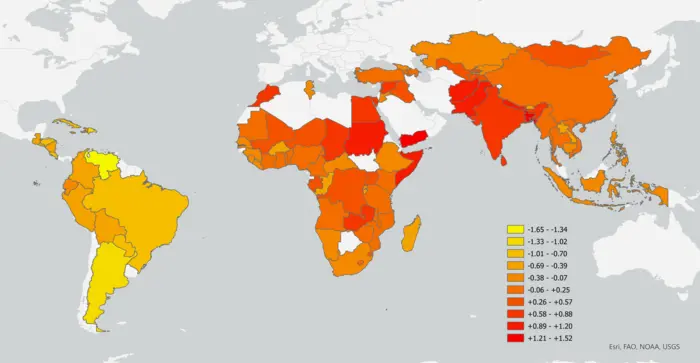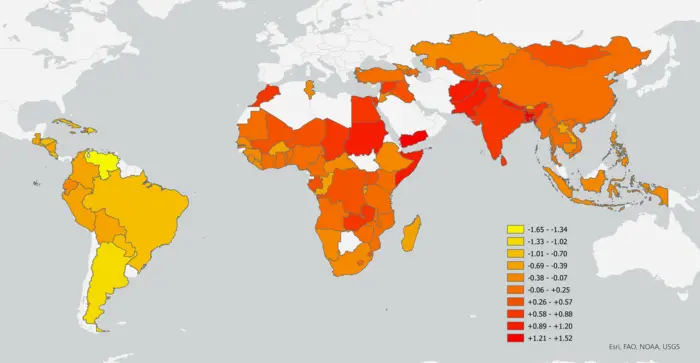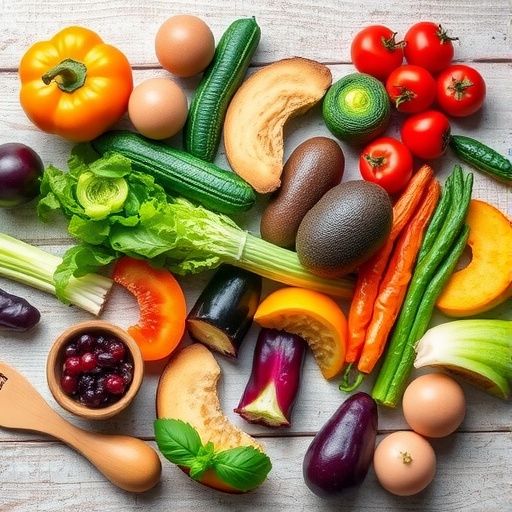Threats posed by the climate crisis disproportionally affect certain communities and social groups that are more exposed. People living in low- and middle-income (LMIC) countries are at heightened risk. Within these countries, women typically face higher climate risk than men.

Credit: Copyright: © 2023 Lecoutere, Mishra, Singaraju, Koo, Azzarri, Chanana, Nico and Puskur
Threats posed by the climate crisis disproportionally affect certain communities and social groups that are more exposed. People living in low- and middle-income (LMIC) countries are at heightened risk. Within these countries, women typically face higher climate risk than men.
To show where women working in agri-food systems – systems that encompass production, but also post-harvest handling and distribution – are most threated by climate change, an international team of researchers has developed a hotspot map that identifies and ranks localities by threat level.
“We show that significant climate hazards, high exposure faced by women in agri-food systems, and high vulnerability faced by women due to systemic gender inequalities converge particularly in central, east, and southern Africa, as well as in west and south Asia,” said the study’s first author Dr Els Lecoutere, who is a researcher at the CGIAR GENDER Impact Platform in Kenya. “The maps are potentially impactful as they can inform decision- and policymaking around gender-responsive climate action and guide the allocation of scarce resources to populations at highest risk.” The results were published in Frontiers in Sustainable Food Systems.
Hotspots for different reasons
“The climate-agriculture-gender inequality hotspot risk index captures the convergence of climate hazards, exposure, and vulnerability because of gender inequalities faced by women in agri-food systems,” said Lecoutere. The team of researchers involved in the study calculated each country’s risk based on these indicators. “We plotted the resulting ‘hotness’ score for each LMIC country into a color-coded map, which makes it possible to compare and contrast risks in different countries.”
The researchers also applied their methodology within four LMIC countries: Bangladesh, Pakistan, Zambia, and Mali. In the global ranking, they took places two, four, 13, and 18, respectively. Multiple drivers of risk contributed to these rankings.
“For the two focus countries in Asia, high climate hazards and women farmers’ exposure drives climate risks, whereas in the two focus countries in Africa structural inequalities play a larger role,” Lecoutere explained.
In Mali and Zambia, secondary resources confirm that women are restricted by norms that hinder their access to land ownership, information, and economic empowerment – limitations that negatively affect their ability to adapt to climate hazards. In Pakistan and Bangladesh, women contribute significantly to agricultural activities, but do so mostly informally. Their work often remains unrecognized, unpaid, or underpaid, which leaves them dependent on agriculture, and vulnerable to the adverse aftereffects of ever more frequent and severe climate hazards.
Starting points for policymaking
The researchers pointed to certain limitations of their study, for example a lack of data that has made it impossible to calculate a ‘hotness’ score for some countries, including small island development states. Yet, it is often these locations that are the most poverty- or conflict-stricken, and therefore vulnerable, making it plausible that women in these environments face significant climate risks.
While the team pointed out that in some cases data might not be available or sufficiently recent to be effectively used for policy making, their findings offer insights for other localities. One possible starting point is reducing women’s sensitivity to harm from climate hazards by addressing systemic gender inequalities and supporting the adaptive capacities of all agri-food system actors in gender-responsive ways.
“Another key use for the results of our study is the upcoming COP28 and ongoing negotiations around a loss and damage fund, and other climate investments. The hotspot maps can help decisionmakers and investors target finance and investments to the areas where women are hardest hit from climate change risks,” Lecoutere pointed out.
Journal
Frontiers in Sustainable Food Systems
DOI
10.3389/fsufs.2023.1197809
Method of Research
Data/statistical analysis
Subject of Research
People
Article Title
Where women in agri-food systems are at highest climate risk: A methodology for mapping climate-agriculture-gender inequality hotspots
Article Publication Date
16-Nov-2023
COI Statement
The authors declare that the research was conducted in the absence of any commercial or financial relationships that could be construed as a potential conflict of interest.





